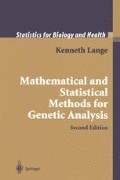Abstract
One of the first chores after a gene is mapped and cloned is to search for similarities between the gene and previously cloned genes. These homologies can illuminate the evolutionary history of the new gene and the structure and function of its derived protein. Indeed, it is fair to say that sequence comparison is the single most useful application of the burgeoning genetic databases. Cross species comparisons are being done on a massive scale to identify gene families, regulatory motifs, and conserved regions within genes. In this chapter, we explore some of the principles and algorithms applied in recognizing DNA sequence patterns and producing optimal alignments between two sequences. Our treatments of both problems are necessarily superficial.
Access this chapter
Tax calculation will be finalised at checkout
Purchases are for personal use only
Preview
Unable to display preview. Download preview PDF.
References
Aldous D (1989) Probability Approximations via the Poisson Clumping Heuristic. Springer-Verlag, New York
Durbin R, Eddy S, Krogh A, Mitchison G (1998) Biological Sequence Analysis: Probabilistic Models of Proteins and Nucleic Acids. Cambridge University Press, Cambridge
Feller W (1969) An Introduction to Probability Theory and its Applications, Vol 1, 2nd ed. Wiley, New York
Grimmett GR, Stirzaker DR (1992) Probability and Random Processes, 2nd ed. Oxford University Press, Oxford
Kruskal JB (1983) An overview of sequence comparison: Time warps, string edits, and macromolecules. SIAM Review 25: 201–237
Needleman SB, Wunsch CD (1970) A general method applicable to the search for similarities in the amino acid sequences of two proteins. J Mol Biol 48: 443–453
Smith TF, Waterman MS (1981) The identification of common mole-cular subsequences. J Mol Biol 147 195–197
Sankoff D, Cedergren RJ (1983) Simultaneous comparisons of three or more sequences related by a tree. In Time Warps String Edits and Macromolecules: The Theory and Practice of Sequence Comparison. edited by Sankoff D, Kruskal JB, Addison-Wesley, Reading, MA, pp 253–264
Schilling MF (1990) The longest run of heads. The College Math J 21: 196–207
Setubal J, Meidanis J (1997) Introduction to Computational Molecular Biology. PWS Publishing, Boston
Waterman MS (1989) Sequence alignments Mathematical Methods for DNA Sequencesedited by Waterman MS, CRC Press, Boca Raton, FL, pp 53–92
Waterman MS (1995) Introduction to Computational Biology: Maps Sequences and Genomes. Chapman and Hall, London
Author information
Authors and Affiliations
Rights and permissions
Copyright information
© 2002 Springer-Verlag New York, Inc.
About this chapter
Cite this chapter
Lange, K. (2002). Sequence Analysis. In: Mathematical and Statistical Methods for Genetic Analysis. Statistics for Biology and Health. Springer, New York, NY. https://doi.org/10.1007/978-0-387-21750-5_13
Download citation
DOI: https://doi.org/10.1007/978-0-387-21750-5_13
Publisher Name: Springer, New York, NY
Print ISBN: 978-1-4684-9556-0
Online ISBN: 978-0-387-21750-5
eBook Packages: Springer Book Archive

